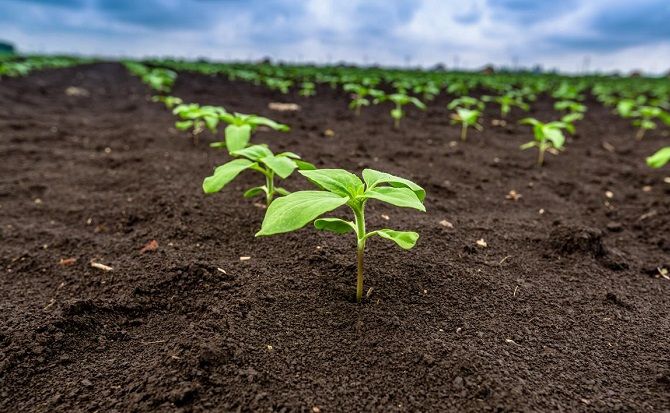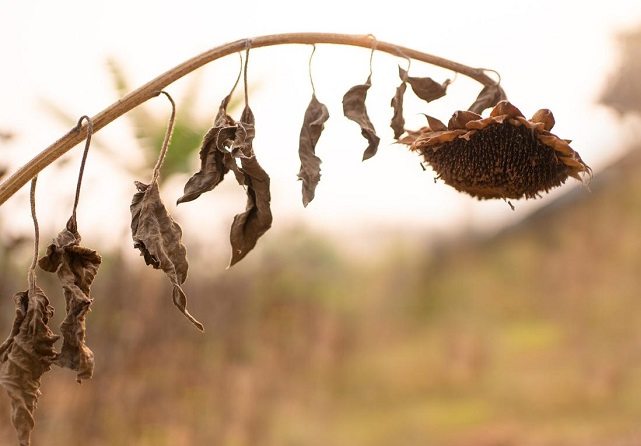Welcome to the wonderful world of sunflowers! With their bright colors and tall height, sunflowers have become a favorite among gardeners and nature lovers.
Have you ever wondered how a sunflower grows from a small seed to a beautiful flower? Understanding the different sunflower growth stages is important for successful gardening.
In this blog post, we’ll explore the fascinating journey of sunflowers, including how they start from a seed, develop as young plants, and eventually bloom into stunning flowers.
Post Contents
Basic Information About Sunflower:
The following table provides a concise overview of basic information about sunflowers.
| Attribute | Description |
|---|---|
| Kingdom | Plantae |
| Division | Magnoliophyta |
| Class | Magnoliopsida |
| Order | Asterales |
| Family | Asteraceae |
| Genus | Helianthus |
| Species | Helianthus annuus |
| Common Name | Sunflower |
| Native To | North America |
| Habitat | Open fields, gardens |
| Lifespan | Annual or perennial |
| Height | Up to 10 feet (3 meters) |
| Flower Color | Yellow, orange, red, brown |
| Flower Size | 2 to 12 inches (5 to 30 cm) in diameter |
| Blooming Season | Summer to early fall |
| Fruit Type | Achene |
| Uses | Ornamental plant, oil production, food source for birds |
| Importance | Symbol of happiness, oilseed crop, bee-friendly plant |
| Notable Varieties | Russian Giant, Teddy Bear, Autumn Beauty |
| Interesting Fact | Sunflowers can track the movement of the sun throughout the day |
Note: Have a look on this video guide on sunflower growth:
Let’s find out how to grow this amazing plant and enjoy the beauty that they bring to your garden with these easy and helpful tips!
1. Germination Stage
The journey of a sunflower begins with germination, where the seed awakens from its dormant state and starts sprouting. Germination requires the right balance of moisture, warmth, and oxygen to initiate successfully.
When provided with optimal conditions, the seed absorbs water, softens, and begins to develop a root and shoot. Patience is key during this stage, as germination can take anywhere from 7 to 21 days.
Read More: 7 Peony Growth Stages: (Guide to Growing Peonies)
2. Seedling Stage
Once the sunflower seed has successfully sprouted, it enters the seedling stage. During this phase, the sunflower develops its first set of true leaves, which look different from the initial cotyledon leaves.

It’s crucial to provide adequate sunlight and water to ensure healthy seedling growth. Care should be taken to avoid overwatering, as excess moisture can lead to root rot.
3. Vegetative Stage
As the sunflower seedling matures, it progresses into the vegetative stage, characterized by rapid growth and the formation of additional leaves. The plant’s stem elongates, and a sturdy stalk develops, allowing the sunflower to reach its towering height.
Providing appropriate nutrition, including a balanced fertilizer, during this stage promotes vigorous growth and strengthens the plant’s overall structure.
4. Budding Stage
The budding stage marks an exciting transition in the sunflower’s growth journey. Buds begin to form at the tops of the plant, signaling the imminent arrival of vibrant sunflower blooms.

To ensure successful flowering, it’s essential to provide adequate spacing between sunflowers, allowing ample airflow and preventing the risk of diseases.
Proper pruning techniques, such as removing weak or overcrowded buds, can enhance the quality of the blooms.
Also Check: 7 Eggplant Growing Stages: How Does it Grow?
5. Flowering Stage
The flowering stage is perhaps the most enchanting phase of a sunflower’s growth. Breathtaking yellow petals unfurl, creating a mesmerizing display that attracts bees, butterflies, and other pollinators.
Pollination plays a vital role during this stage, as it determines the formation of seeds. Regular deadheading, which involves removing spent flowers, can extend the blooming period and encourage the production of new flowers.
6. Seed Formation Stage
After the petals have withered away, the sunflower transitions into the seed formation stage. The flower’s center, known as the receptacle, becomes home to hundreds of developing seeds.
Factors such as pollination success, availability of nutrients, and the plant’s overall health influence the seed development process. Careful observation and timely protection from birds or pests are crucial during this stage to ensure a bountiful seed harvest.
7. Ripening Stage
The ripening stage signifies the approaching end of a sunflower’s growth cycle. The seeds inside the flower heads gradually mature and dry out, changing from green to brown or black. As the seeds ripen, the flower heads may droop or face downward.

This stage is critical for harvesting sunflowers intended for seed consumption or oil production. Once the majority of the seeds have dried, the sunflower is ready for harvest.
Tips to Grow Sunflowers
Here are some tips to help you grow sunflowers successfully:
- Choose the Right Variety: There are different varieties of sunflowers available, including dwarf varieties for containers, giant varieties for tall displays, and colored varieties for unique aesthetics. Select a variety that suits your space and preferences.
- Select a Sunny Location: Sunflowers thrive in full sun, so choose a location in your garden that receives at least 6-8 hours of direct sunlight per day. Ensure that the spot has well-draining soil.
- Prepare the Soil: Sunflowers prefer fertile soil with good drainage. Before planting, loosen the soil and remove any weeds or debris. Incorporate organic matter like compost to improve soil fertility.
- Planting: Plant sunflower seeds directly in the soil once the danger of frost has passed and the soil has warmed up. Follow the instructions on the seed packet for the recommended planting depth and spacing.
- Watering: Water the soil thoroughly after planting to ensure good seed-to-soil contact. Once the seedlings emerge, water them regularly, keeping the soil moist but not waterlogged. Be mindful of drought conditions and increase watering during hot and dry spells.
- Provide Support: Depending on the variety, sunflowers can grow tall and heavy. Provide support such as stakes or trellises to prevent them from toppling over due to wind or their weight.
- Fertilizing: Sunflowers are not heavy feeders, but you can apply a balanced fertilizer or compost when planting to provide some nutrients. Avoid over-fertilizing, as it can lead to excessive leaf growth and fewer blooms.
- Mulching: Apply a layer of organic mulch around the base of the sunflowers to help retain soil moisture, suppress weed growth, and regulate soil temperature.
- Pest and Disease Control: Monitor your sunflowers regularly for pests like aphids, snails, or slugs. Use organic pest control methods or insecticidal soaps to manage infestations. Also, be on the lookout for common diseases like powdery mildew and rust, and take appropriate measures to prevent or treat them.
- Deadheading: To promote continuous blooming, remove spent flowers by gently pinching them off or cutting them just above a leaf node. This encourages the plant to produce more blooms.
- Harvesting Seeds: If you’re growing sunflowers for their seeds, allow the flower heads to fully mature and dry on the stalk. Harvest them by cutting the heads and hanging them upside down in a well-ventilated area. Once the seeds are dry, gently rub them to remove them from the flower head.
By following these tips, you can enjoy the beauty of sunflowers and experience the joy of growing these magnificent plants in your garden.
FAQs About Sunflower Growth Stages
1. How long does it take for a sunflower to grow?
The time it takes for a sunflower to grow depends on various factors such as the sunflower variety, growing conditions, and climate. On average, it takes approximately 80 to 120 days from germination to seed maturity.
2. Can sunflowers grow in pots or containers?
Yes, sunflowers can be grown in pots or containers. Choose a large container with adequate drainage and ensure it receives plenty of sunlight. Opt for dwarf or compact sunflower varieties that are better suited for container gardening.
3. Do all sunflowers face the sun?
While sunflowers are known for their ability to track the movement of the sun, it’s a common misconception that all sunflowers face the sun. Most young sunflower buds face east and gradually turn to face the sun as they mature. However, some sunflower varieties exhibit little to no heliotropism.
4. Can sunflowers tolerate frost?
Sunflowers are generally sensitive to frost and prefer warm climates. However, certain sunflower varieties have been bred to be more tolerant of cooler temperatures. It’s advisable to check the specific variety’s cold tolerance and provide appropriate protection during frosty periods.
5. How can I prevent pests from damaging my sunflowers?
To deter pests from damaging sunflowers, you can implement various measures such as companion planting with pest-repellent plants, using organic insecticides or repellents, placing physical barriers like netting, and regularly inspecting plants for signs of pests. Additionally, encouraging beneficial insects like ladybugs and praying mantises can help control pest populations naturally.
Conclusion
Understanding the growth stages of sunflowers allows us to appreciate these magnificent plants more deeply. From germination to ripening, each phase brings its own unique beauty and requirements.
By providing proper care, including adequate sunlight, water, nutrition, and protection from pests, gardeners can nurture sunflowers and witness the breathtaking transformation from tiny seeds to towering blooms. Remember to observe and celebrate each stage of growth, and your sunflower patch will flourish with vibrant colors and joy.
Related Articles:

